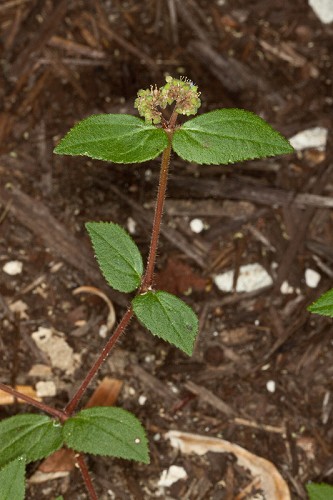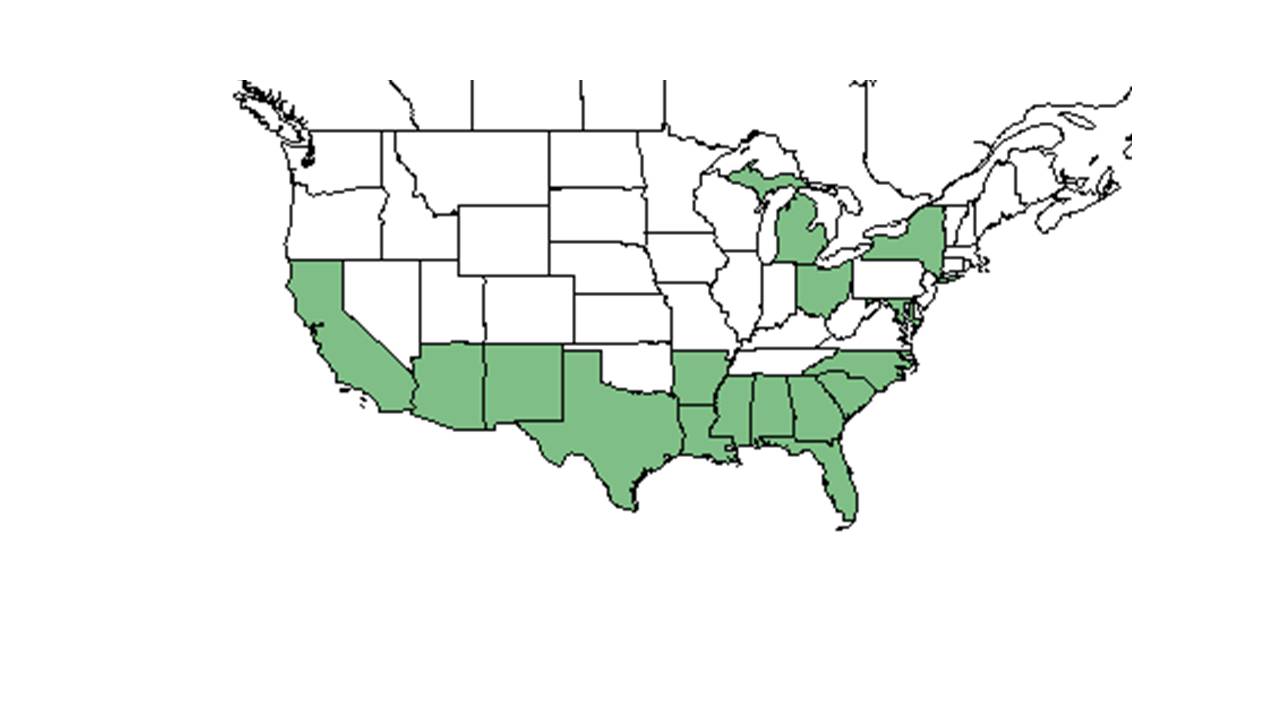Difference between revisions of "Euphorbia hirta"
(→Cultural use) |
|||
| Line 46: | Line 46: | ||
==Cultural use== | ==Cultural use== | ||
| + | Members of this genus can be used as a laxative in small amounts, but an overdose can cause severe poisoning.<ref> Mueschner, W.C. 1957. Poisonous Plants of the United States. The Macmillan Company, New York.</ref> | ||
| + | |||
==Photo Gallery== | ==Photo Gallery== | ||
<gallery widths=180px> | <gallery widths=180px> | ||
Revision as of 13:42, 10 June 2021
| Euphorbia hirta | |
|---|---|

| |
| Photo by John R. Gwaltney, Southeastern Flora.com | |
| Scientific classification | |
| Kingdom: | Plantae |
| Division: | Magnoliophyta - Flowering plants |
| Class: | Magnoliopsida – Dicotyledons |
| Order: | Euphorbiales |
| Family: | Euphorbiaceae |
| Genus: | Euphorbia |
| Species: | E. hirta |
| Binomial name | |
| Euphorbia hirta (L.) Millsp. | |

| |
| Natural range of Euphorbia hirta from USDA NRCS Plants Database. | |
Common name: Pillpod sandmat
Contents
Taxonomic notes
Synonyms: Chamaesyce hirta (Linnaeus) Millspaugh.[1]
Varieties: none.[1]
Description
Distribution
This species is found from eastern North Carolina to central South Carolina, as far south as southern Florida, and as far west as Texas. It also occurs in Central and South America.[1]
Ecology
Habitat
It has been observed to grow in disturbed areas such as lawns, gardens, roadside depressions, vacant lots, fallow fields, and parking lots. It can grow in dry sands and silty loam on mesic areas as well.[2]
Phenology
This species has been observed to flower and fruit from July to August. [3]
Conservation, cultivation, and restoration
Cultural use
Members of this genus can be used as a laxative in small amounts, but an overdose can cause severe poisoning.[4]
Photo Gallery
References and notes
- ↑ 1.0 1.1 1.2 Weakley, A.S. 2015. Flora of the southern and mid-atlantic states. Working Draft of 21 May 2015. University of North Carolina at Chapel Hill, Chapel Hill, North Carolina.
- ↑ Florida State University Robert K. Godfrey Herbarium database. URL: http://herbarium.bio.fsu.edu. Last accessed: June 2014. Collectors: L. C. Anderson, W. R. Anderson, A. Clewell, K. Blum, M. R. Crosby, J. Duke, J. Dwyer, S. F. da Fonseca, R. K. Godfrey, H. A. Hespenheide, H. S. Irwin, R. Komarek, R. L. Lazor, H. Loftin, T. MacClendon, K. MacClendon, E. Onishi, J. Ramos, R. Reis dos Santos, T. R. Soderstrom, R. Souza, and E. L. Tyson. States and Counties: Florida: Calhoun, Franklin, Jackson, Leon, Liberty, and Wakulla. Georgia: Thomas. Other countries: Brazil, Honduras, Panama, Costa Rica, and Jamaica.
- ↑ Florida State University Robert K. Godfrey Herbarium database. URL: http://herbarium.bio.fsu.edu. Last accessed: June 2014. Collectors: L. C. Anderson, W. R. Anderson, A. Clewell, K. Blum, M. R. Crosby, J. Duke, J. Dwyer, S. F. da Fonseca, R. K. Godfrey, H. A. Hespenheide, H. S. Irwin, R. Komarek, R. L. Lazor, H. Loftin, T. MacClendon, K. MacClendon, E. Onishi, J. Ramos, R. Reis dos Santos, T. R. Soderstrom, R. Souza, and E. L. Tyson. States and Counties: Florida: Calhoun, Franklin, Jackson, Leon, Liberty, and Wakulla. Georgia: Thomas. Other countries: Brazil, Honduras, Panama, Costa Rica, and Jamaica.
- ↑ Mueschner, W.C. 1957. Poisonous Plants of the United States. The Macmillan Company, New York.